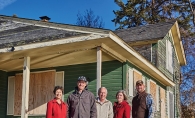Wayzata Public Schools’ Early Learning School provides more than services and programs for the district’s children. It also fosters connections among families and district staff, and puts parents at the starting line of their children’s formal education. “It’s where school begins for their child and where their relationship begins with the district,” says Sandi Arndt, family education coordinator.
Open since February, the school brings together the Wayzata Public School Welcome Center, Early Childhood Screening, Early Childhood Family Education (ECFE), Early Childhood Special Education (ECSE), Peppermint Fence Preschool (ages 2 to 5 years) and Wayzata Home Base-Bright Start Child Care. “We really wanted it to be a one-stop location for the families,” say Arndt, who coordinates the early childhood programs, including Peppermint Fence and ECFE.
“It seems, in this new space, there is a lot more cohesiveness,” Michelle Ugurlu says. As a district parent to three children ages 5, 3 and 1, Ugurlu has more than a passing interest in the district’s programs. She says the Early Learning School helps families integrate better than when programming was housed at different sites, including Central Middle School and at Plymouth Presbyterian and Wayzata Community churches.
Ugurlu also stresses the importance of family participation. “I think it’s invaluable,” she says, noting the school allows for impromptu conversations between parents and staff, who are “very open to offering suggestions,” she says, when parenting concerns or questions arise away from parenting classes.
“Families feel part of something bigger and part of a community,” says Robin Henslin, special services supervisor. She adds that in order for parents to be involved in children’s education, they need a sense of belonging, which the school fosters. On a practical level, Henslin, who oversees the Early Childhood Screening and ECSE programs, says parents benefit from having access to programs and resources for children of any age. “It all seems to be easy for them—a sense of comfort that everything is right here,” she says.
While children and families benefit from the cohesiveness of the school, Arndt says the 70-member staff also finds value there. “Everyone has different experiences,” she says. “More heads are better than one, as we put it all together.”
Henslin echoes that sentiment. “Collaboration is much stronger,” she says.
The 25,000-square-foot facility features additional space, allowing for added sections for established programs. Once home to the Minnesota School of Business, the one-level structure was remodeled to include child-friendly elements and a community room, which is used for special events and, more often, as a space for parents to gather while their children attend classes. “It’s not uncommon for us to have 10 or 15 parents in there chatting, building their own community,” Arndt says.
The district also took special care in designing the learning school’s “outerwear”—its name and logo. “Referring to the site as a school demonstrates that the district values the learning that occurs during this segment of time (birth up to kindergarten), just as we value the learning that occurs in our elementary, middle and high schools,” according to the district. The logo’s sprout represents young, new growth. “This simple, whimsical, storybook-style image appears eager, as if it is about to burst with new growth,” say district representatives. “The arc of the sprout mimics the arc of the district logo’s embracing laurel wreath, symbolic of growth, inclusivity and achievement.” Green serves two purposes: representing growth and vitality while highlighting the word “early” to emphasize the importance of early screening, diagnosis, intervention, treatment and education.
Program catalogues are mailed out in early January to district families with children ages birth to 4. Registration for the following school year begins in February.









